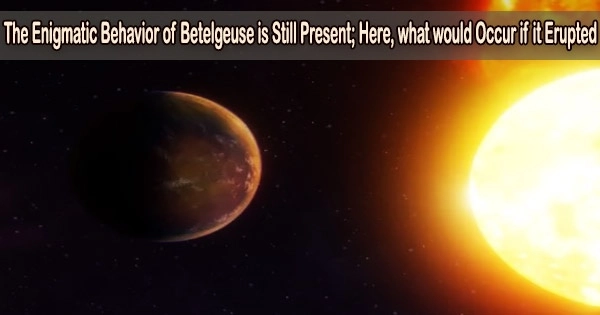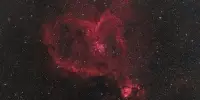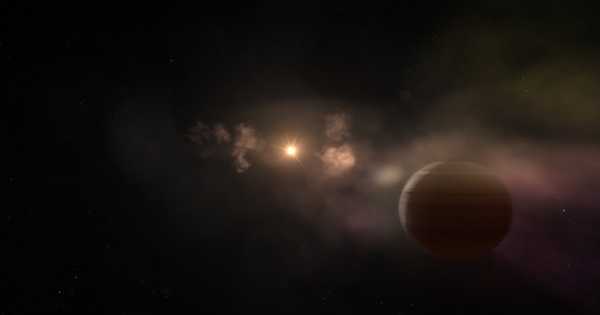Orion’s brilliant, crimson star Betelgeuse has exhibited some peculiar behavior lately. It got fainter in the latter part of 2019 and 2020 than it had ever been, at least according to records going back more than a century. It briefly dimmed until it was nearly as bright as Bellatrix, the third brightest star in Orion. This event became known as the “great dimming.”
But Betelgeuse has since become bright again. It was Orion’s brightest star for a few days this year, shining brighter than we had ever seen it. Both incidents raised the question of whether it was going to explode and end its existence.
But is there any evidence to support this idea? And how would such an explosion affect us here on Earth?
Stars are, by and large, remarkably stable. Year after year, they continue to sparkle with the same intensity. There are, however, some variable stars, which are stars whose brightness varies. Most famous is Mira, the “star of wonder,” which was discovered as a variable star by the German pastor David Fabricius in 1596 it is a pulsating star which regularly expands and contracts.
Algol is another well known example: it is periodically eclipsed by a companion star. The brightness of about 30 of these variable stars can be seen with the unaided eye, but it takes some effort to do so.
Betelgeuse, the seventh brightest star in the sky (discounting the Sun), is the brightest of the variable stars. Sometimes Betelgeuse becomes nearly as bright as Rigel (the blue fourth brightest star in the constellation), while at other times it is notably fainter. Pulsations, which are comparable to those of Mira but not as strong or consistent, are what produce the fluctuation.
However, a star occasionally experiences brief bursts of intense brightness. The supernovas, generated when a complete star ends its existence in a massive explosion, are the brightest and rarest of those.
Supernovas have only happened a few times in the past 1,000 years, but they can be brilliant enough to be seen during the day. A nearby, bright supernova is the kind of event astronomers live for but which few of us will ever get to see. We live in hope.
Mysterious behavior
Although Betelgeuse is a variable star, the great dimming in 2021 was extreme. In fact, it had darkened by nearly 60% in just a few months. In the end, it was determined that a cloud was to blame. Stars like Betelgeuse are constantly ejecting dust and gas. Half of the star was hidden by a clump of gas in the wind that was as big as the star itself. In actuality, the star’s southern half was absent from photos of it. Some stars, like Betelgeuse, seem to have weather.
That said, we still don’t know what caused the sudden brightening it is now 50% brighter than usual. But an impending supernova doesn’t seem that likely. In these kinds of stars, a supernova explosion is triggered in the core. Brightness variations, on the other hand, are a surface phenomenon.
The same dust cloud that produced the dimming and is now bouncing light from the star towards us may perhaps be to blame for the extraordinary brightening.
But we can’t be sure, and astronomers are excited. Betelgeuse is a star with a mass that is between 15 and 20 times that of the Sun, and stars with this mass are thought to end their lives in a supernova explosion. Because Betelgeuse is a red supergiant, its crimson tint indicates that it is already nearing the end of its existence.
But that end may still be a million years away. While more than 10 million years may seem like a relatively short time to astronomers, it is a very long time to anybody else for stars like Betelgeuse.
Despite this, new models have been developed, with some predicting that a supernova will occur in a few thousand years and others estimating that it will happen 1.5 million years from now.
There are many mysteries around Betelgeuse. We don’t know its precise mass and even its distance is disputed. It is argued that the star merged with a smaller companion recently: this would explain why it rotates faster than expected large stars usually do.
Some ancient manuscripts refer to the star as similar to yellow-ish Saturn, rather than ruddy Mars. Has the star changed color? That would indicate rapid evolution, which would suggest that a supernova might occur sooner rather than later.
Explosion dynamics
If Betelgeuse does go supernova, what would it look like? The star is around 500 light years away. Following an explosion, we first would detect a rain of massless particles called neutrinos, which would be harmless to us. After that, the star would quickly brighten.
It would shine with almost the same brightness as the full Moon after one or two weeks. Then, over the next months, Betelgeuse would start to wane, although it would still be visible during the day for six to twelve months.
For another year or two, you should be able to see it clearly at night with the unaided eye. But after then, we wouldn’t see it again, and Orion would never again have its signature crimson gleam.
Is there any danger to us? Cosmic rays, which are produced by supernovae, are high-energy particles that can penetrate the Earth’s magnetic field. However, aside from the closest supernovas, the amounts would be negligible in comparison to other radiation humans are exposed to.
A supernova explosion would also create radioactive iron. This substance, which has actually been discovered on the Moon and in the seafloor of the Earth, is thought to have created in a supernova explosion between two and three million years ago. That supernova was about 300 light years away from us, so it was closer than Betelgeuse but still sufficiently remote to not pose a serious threat to life as we know it.
A very close supernova, closer than 30 light years, could cause major problems: the cosmic rays could cause ozone destruction and dangerous UV levels on Earth. This level is thought to be capable of producing an extinction catastrophe since it may cut ozone levels in half over a period of hundreds to thousands of years. However, such a near supernova would be extremely uncommon and might only occur once every billion years.
Ultimately, Betelgeuse may still be around for some time. And that’s good, as it is a fascinating and mysterious star. We still have a lot to learn from it.
















